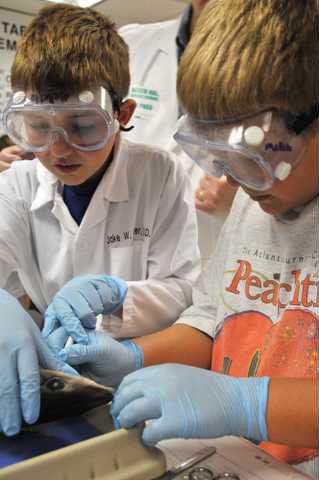As students entered Cathy Dial’s class, many pinched their noses to block out the unusual stench.
The odor was coming from 5- to 6-pound sharks, which children from Mount Vernon Elementary’s gifted program were tasked with dissecting Thursday.
“Children are fascinated by sharks, adults are, too,” Dial said. “They have a very different organ system than our own.”
For the experiment, Dial borrowed lab space at North Hall Middle School. About 30 fifth-graders had an hour to cut open and identify parts they’ve been studying over the past several weeks. Her fourth-grade students tried the experiment Wednesday.
Dial said most children don’t begin taking dissection lessons until seventh grade. Few elementary school-level students get the opportunity.
“They had to show commitment to earn the privilege to go,” Dial said.
The students were required to earn at least a 90 percent on an anatomy exam to dissect the fish.
They were also given a safety course the week before.
“Some of the kids don’t cut their own meat at the dinner table or don’t know how to hold a knife,” she said. “But no one got hurt and they took it very seriously.”
Dial said many of the children were anxious to open the stomach and identify the shark’s last meal. One group discovered a partially digested octopus and crab.
The 14 spiny dogfish sharks were ordered from Carolina Biological, a science supply company.
Meredith Lynn, 11, said she was looking forward to examining a real-life shark, rather than study a computer program.
But it still made her feel squeamish at first.
“Oh my gosh! I’m not going to look!” she said, as she made the first incision.
Dial had each of her students name the shark, to recognize that it was once a living being. They were also asked to write a letter to the shark, to reflect on their feelings about the dissection.
“The homework helps them debrief,” Dial said.
Dial, and the parent volunteers, also escorted students to another classroom if they felt queasy or faint that day.
Dial said the lesson helped students think about their own anatomy as they compared organs they saw in the shark to their own. She added that her students are hungry for advanced learning opportunities such as this.
“If you give them a challenge, they rise to it,” she said.

